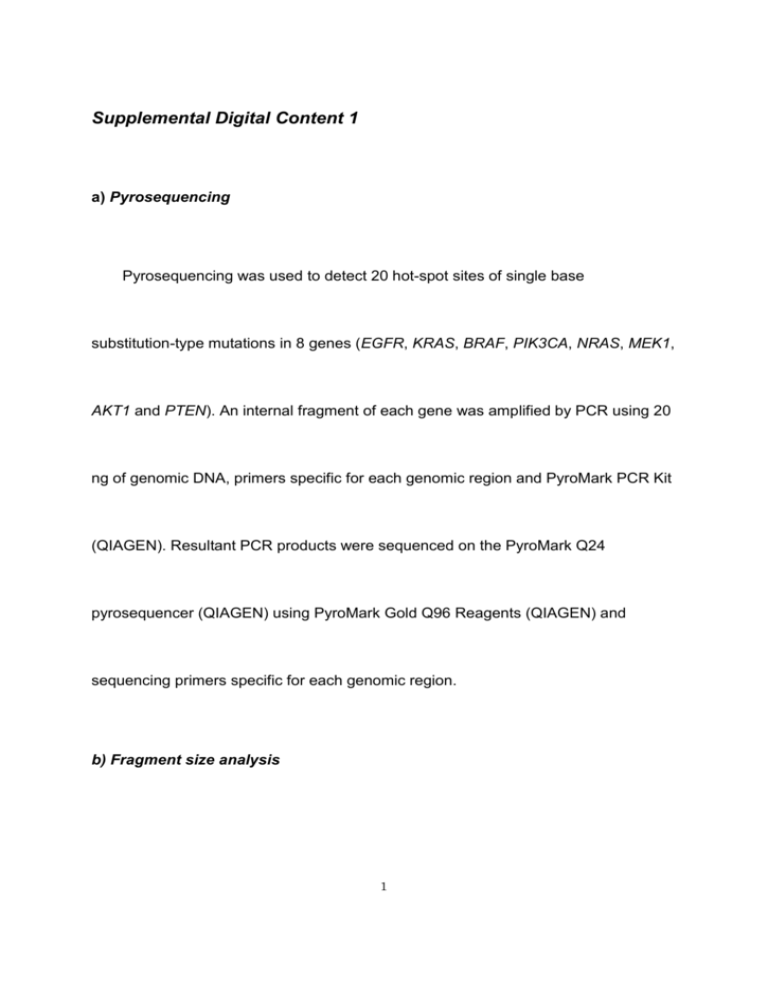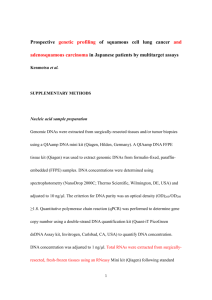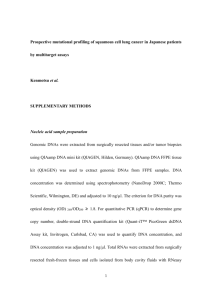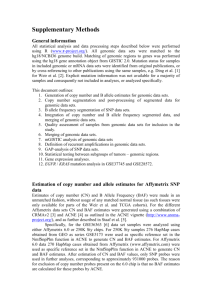TITLE PAGE
advertisement

Supplemental Digital Content 1 a) Pyrosequencing Pyrosequencing was used to detect 20 hot-spot sites of single base substitution-type mutations in 8 genes (EGFR, KRAS, BRAF, PIK3CA, NRAS, MEK1, AKT1 and PTEN). An internal fragment of each gene was amplified by PCR using 20 ng of genomic DNA, primers specific for each genomic region and PyroMark PCR Kit (QIAGEN). Resultant PCR products were sequenced on the PyroMark Q24 pyrosequencer (QIAGEN) using PyroMark Gold Q96 Reagents (QIAGEN) and sequencing primers specific for each genomic region. b) Fragment size analysis 1 Three insertion/deletion-type mutations (indels) in EGFR and HER2 were determined by sizing the PCR-amplified product using capillary electrophoresis (QIAxcel Advanced, QIAGEN). PCR was performed with 20 ng of genomic DNA, primers specific for each genomic region containing indels and PyroMark PCR Kit (QIAGEN). c) Quantitative PCR Quantitative PCR (qPCR) for evaluation of 5 gene amplifications (EGFR, MET, FGFR1, FGFR2 and PIK3CA) was performed on the StepOnePlusTM Real time PCR system (Applied Biosystems, Foster City, CA) using 2 ng genomic DNA, PCR primers for each gene and SYBR® Premix Ex Taq™ II (Tli RNaseH Plus) (TAKARA BIO, Shiga, Japan). To draw the standard for quantification of target gene copies, plasmids 2 containing DNA fragments for each gene were constructed with TOPO TA cloning kit containing pCR2.1-TOPO vector (Invitrogen). Serial dilutions (7 step dilutions from 102 to 108 copies) of the plasmids were used to generate standard curves. The copy number of each gene was normalized by the copy number of LINE-1. Gene copy number changes were determined by the ratio of normalized quantity in the target gene to that in COL8A1 gene. Primers used in this study are available upon request to the corresponding author. When the copy number of the target gene was at least twice that of negative control cell lines, that sample was judged as possessing amplification. d) RT-PCR for the detection of fusion genes 3 Fusion genes were detected by reverse-transcription PCR (RT-PCR). The cDNA templates synthesis was performed with total RNA (1 μg), Oiligo(dT)12-18 Primer (Invitrogen) and Omuniscript RT Kit (QIAGEN). Detection of EML4-ALK and ROS1 fusion genes (CD74-ROS1 and SLC34A2-ROS1) was performed in accordance with Sun et al (J Clin Oncol 2010; 28(30): 4616-4620) and Li et al (PLoS One 2011; 6(11): e28204), respectively. Methods for detection of KIF5B-RET and CCDC6-RET fusion genes were kindly provided by Dr. Takashi Kohno (National Cancer Center, Tokyo). 4








